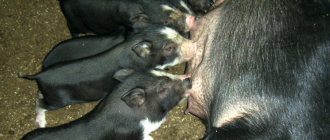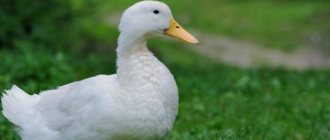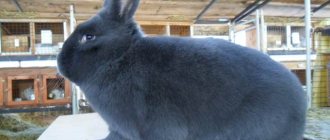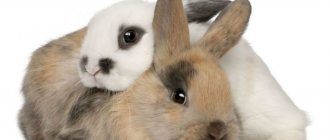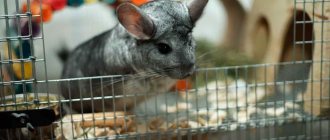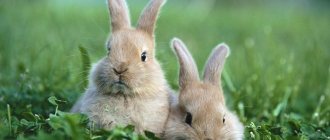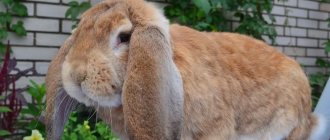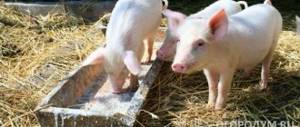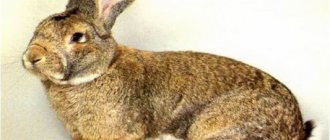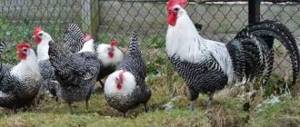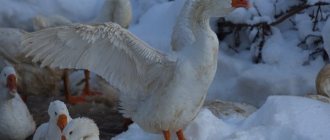Proper keeping of rabbits in enclosures: detailed experience
Many rabbit breeders use cages for keeping them. However, by their nature these creatures are active and sociable; in cages they are lethargic and prone to disease, since there is little movement. Rabbit breeders who care about the health of their animals keep their pets in enclosures. “In the wild,” although artificial, they can jump, run and have as much fun as possible. Of course, keeping an enclosure will be an excellent place for animals, in contrast to cramped cages.
Rabbits in an enclosure
Many people are interested in detailed experience about keeping rabbits in enclosures, what features and subtleties need to be observed. True, there are cases when breeders were unable to keep animals this way, so they returned to the standard form of keeping, despite the fact that enclosures are a more economical option.
Let the rabbit out of the cage
To the credit of the author of this material, he has thoroughly studied the experience of many generations of rabbit breeders and logically comes to the conclusion about the advantages of cage-free keeping of animals. But in our opinion, one of the reasons that is holding back the resumption of this truly rational method of keeping rabbits is the lack of not only large areas for grazing animals, but even a place to organize an enclosure. But we still recommend that those who live in the village listen to these tips. And yet the main thing is to ensure control over the health of the animals. In those days, there were no such terrible diseases as rabbit viral hemorrhagic disease (RVHD) and myxomatosis. I want to share my method of breeding rabbits. My method is not new, but, as they say, a well-forgotten old one. It all started when I discovered two animals with swollen bellies. They sat in cages with their heads down, motionless. They looked depressed, their fur was disheveled. I felt sorry for the animals and I released them to die. After sitting for a while, they galloped to the potato patch and began to eat the green tops of the potatoes. By morning they had disappeared. And imagine my surprise when I saw these animals completely healthy a week later. They jumped merrily around the same potato patch. After this incident, I began to wonder why all living creatures enjoy some kind of freedom, but rabbits are prisoners for life. And I began to look for at least some publications about the free keeping of rabbits.
Here are a few excerpts from books and pamphlets of the last century.
“You can keep rabbits in cages or free in a fenced yard. With rational management, the latter method is the best, and there is nothing more beautiful and interesting than enclosures with rabbits, especially when they play and frolic.”
V.V. Sabinetsky, “Rabbit”, 1906
“The cage forces the rabbit, which is clean by nature, to defecate near its feeder, get dirty and constantly breathe in the smell of manure, which contributes to disease. Walking in rabbit farming is of enormous importance. This was fully confirmed by the experience conducted at the Zverovod partnership, where in late autumn several pairs of rabbits suffering from purulent runny nose were released into enclosures. By spring, they and their offspring showed no signs of illness.”
A.N. Morozov.
“In 1930, in the Chegodaevsky nursery, a veterinarian let forty rabbits hopelessly exhausted by coccidiosis onto the grass “to die in freedom,” and they, to the surprise of the cage ideologists there, completely recovered, despite the dampness and contamination of the soil. The cage puts the rabbit in unnatural conditions. This animal is very energetic, active, cheerful, curious and so hardy that it can even endure a cage for quite a long time. But he receives the most lasting health and good development only in enclosures and cages, if, of course, someone manages this with understanding.”
K.I.Gadzyatsky.
“If I were forced to keep rabbits in cages, I would prefer to stop this activity altogether, since, raising them in hundreds, I do not have such troubles with diseases as those who keep them in cages. The health and strength of animals is the main thing to be taken care of, and this is only possible when the animal has plenty of light, air and exercise.”
Translation from English.
“In early spring, I placed several breeding rexes in a large pen where they could frolic freely. My rexes do not know either stomach diseases or colds. Many visitors were dumbfounded with pleasure, seeing how the rabbits with great appetite ate wet cabbage leaves and frost-covered grass without the slightest harm.”
Translation from German.
“The females get along well with each other, willingly make nests in artificial burrows and, what is especially interesting, collectively feed the little rabbits running out of the nest, without distinguishing whether they are their own or someone else’s. Adequate milk nutrition and exercise in the fresh air have a beneficial effect on baby rabbits, and at weaning they are approximately one and a half times larger than their peers of the same breed raised in cages.”
F.V. Nikitin.
Once released into the wild, the animal is transformed. Lethargy and apathy disappear in some people, nervousness and anger in others disappear. High jumps and leaps, rapid zigzags and running - everything expresses the boundless joy of the feeling of freedom. Then you see what a real rabbit is - a dexterous and smart creature, perfectly adapted to life in the wild. Sensitive ears and springy paws, precise movements, instant reaction, unmistakable orientation. You can’t help but be amazed at how many generations of cell prisoners managed to preserve all this. Is it reasonable and economical for a person to deal with this living gift of nature? Current rabbit farming, based on keeping animals in cramped cages, differs from other branches of animal husbandry in this alone. There is a rule in animal science: the productivity of an animal depends not only on feeding, but also on how its other natural needs are satisfied, and especially motor activity - the most natural need of a living creature. Why, you ask, has cage-free rabbit farming, with such obvious advantages, never come into practice? Yes, they simply ignorantly used free content and discredited it. The rabbits were released where there was no food for them, they were left without protection and veterinary supervision, without complementary food, without shelters; the offspring died in burrows flooded with water and were destroyed by predators. In my method, I took all the best from cage breeding - this is constant monitoring of animals and their offspring, and aviary breeding - this does not require daily cleaning of cages, feeding, rabbits on pasture from April to the end of October. I will answer anyone who is interested in this method for free. From you - an envelope with a return address.
SERBA Alexander Nikolaevich, st. Knyazhichenko, 1, Krasny Luch, Lugansk region, 94502.
https://www.donbass.dn.ua/hoziain/ferma.php
Arrangement of the enclosure
An enclosure for animals is an open space, which is fenced around the perimeter with a special fence. The dimensions of this place depend on the number of individuals. They need to be done on higher ground to avoid flooding. It is recommended to make the walls from any building material at hand. One side should be made of mesh so that the room is ventilated. The height should be about a meter, or even better, one and a half meters, since the animals jump high.
To save money, you can make an enclosure with a dirt floor. Only in this case you need to make protection from the outside so that the pets do not escape. The walls are buried half a meter into the ground, or metal rods are driven in around the perimeter every 10 cm, the length of which should be 1 meter. The earth floor has its advantages - it does not require constant cleaning. In addition, pets can dig minks and develop physically.
The mesh must be treated with an anti-corrosion agent in order to use it longer
The floor can be poured with concrete to make something like a cage, only without a roof. To make cleaning easier, it can be made from mesh. However, not all types of rabbits can be kept on a cellular floor, as they can develop pododermatitis. The concrete surface is insulated with sawdust or dry grass. The area of the enclosure must be covered with a canopy so that the animals are not afraid of precipitation. You can build one large barn for animals or a couple of small houses that are raised above the ground.
The walls of these structures are lined with mesh so that the animals do not sharpen their teeth. It is recommended to keep small rooms in the form of queen cells. To quickly clean the house, you need to make the roof like a mailbox. It is important to provide the entire population with food and water, as rabbits can be aggressive towards each other. They also need to be given twigs, as they like to chew on things. What branches can you give to rabbits? It is best to give twigs of apple, currant and acacia.
Feeding rabbits
If the creatures are in enclosures, it is important to protect them from bad temperatures. Large boxes that are lined with waterproof fabric are suitable for these purposes. If the fence is small, about 20-26 sq.m., then 30 heads can be placed there, including 5 males and 25 females. Or about 25 heads of young animals. When there is a need to unite rabbits from different places, they are released into the enclosure at the same time, and fragrant grass or some kind of delicacy will remove the smell of “strangers”.
When the animals get used to each other, novices should not be brought here under any circumstances. Also, pregnant individuals who did not know each other before are not combined. The animals develop an instinct to protect their home. If the rabbits have been together since early childhood, then there will be no difficulties.
The meat is rougher
Some aspects of keeping rabbits freely are inferior to the cage type. The spread of infections in livestock has already been discussed above. There is also information that rabbits that live in freedom have tougher meat than captive animals.
If it is possible to keep rabbits in an enclosure, then it must be done thoroughly. Read about this in the article “Peculiarities of keeping rabbits in enclosures.” An important step is digging the fencing mesh into the ground, approximately 1 m. Sometimes the floor surface is concreted so that the rabbit does not dig a tunnel. However, digging is a characteristic feature of these animals. Therefore, the enclosure can only be partially concreted around the perimeter.
In a free-range environment, the bad thing is that it is difficult to catch a rabbit for any kind of processing, treatment, or spawning. Moreover, difficulties with catching arise when the animal has escaped from the territory.
Problems may also arise with predators that like to hunt rabbits - birds, foxes, ferrets.
As protection, thorny bushes can be planted along the perimeter of the grazing area and near holes. Breeding rabbits freely is also not easy. Here it is important to control that related individuals do not mate. Breeding animals are still kept separately, more often in cages.
Specifics of enclosure keeping and feeding
Animals must be accommodated at the same time. If the animals are from different nests, then you need to fight off the smell with a tasty treat. Female rabbits who have known each other for a long time will be friends both during pregnancy and at the time of birth, but they will not accept someone else’s rabbit. When introducing rabbits, you need to carefully examine them to ensure there are no infections or parasites. It is recommended to get vaccinated against major diseases.
Grain for rabbits
What grain to feed rabbits? The best food for rabbits is considered to be wheat, barley and oats. Animals consume them with great pleasure, and besides, these crops are always available. They are also given corn. Oats, in turn, are absorbed in the body faster than barley and do not add excess fat to the animals. If you feed a lot of wheat, your pets will get bloated. That is why experienced farmers mix crops so as not to aggravate the situation.
Do not forget about water, which should always be in the drinking bowl. It is advisable to change it twice a day. It is important to be able to prepare grain, that is, to understand how much of what to put. For example, corn and barley need to be crushed and then poured with boiling water. Wheat and oats, on the contrary, are given in their pure form, since animals easily chew them without softening.
- Keeping rabbits in enclosures is not recommended on medium or large farms where animals are bred for meat. Since rabbits are free-range, the body will be rich in muscle tissue. This meat has a scarlet tint and tastes tough. It is much more difficult to implement than the delicate production of cell pets.
- If the infection does get into the room, everyone will quickly die.
- Keeping animals this way is difficult in cold weather. For the winter, you will have to move all the livestock to a warm place or slaughter the young animals.
Read also: “Enroxil”: instructions for use in veterinary medicine
Now about the advantages of this technique:
- An aviary is much more economical than cages. Few materials are required for construction, and the same goes for feeders.
- This is a less labor-intensive process. To serve each animal, you don’t need to open and close a bunch of cages. The aviary needs to be cleaned less frequently than a cage.
- If you use sawdust as bedding, you will end up with good fertilizer for the garden.
When rabbits are in an enclosure, they feel free, which increases their food cravings and improves their mood as they can have fun there.
Rabbits in an enclosure - on video:
Subsidiary farm
* Rabbits are the most precocious and prolific animals. The young grow very quickly, and a four-month-old animal can already weigh up to two kilograms. Rabbit meat is very tender and tasty, and also dietary. From one female rabbit you can get up to 50 kg of meat per year due to the offspring, and from rabbits of downy breeds an additional 1 - 1.5 kg of fine fluff.
When kept in cages, rabbits need to be constantly looked after (clean cages, change water, bedding, etc.). They simply trample down a lot of food. In cages, animals move little and, in my opinion, develop worse and get sick more often. If they are kept away from home, for example, in a country house, then there is a high probability that your long-eared pets will simply be taken away. In addition, daily bus trips will also cost a pretty penny. One way or another, but man, figuratively speaking, is attached to animals. Therefore, in order to eliminate all the unpleasant moments, I decided that freely keeping rabbits in the country has a number of significant advantages. Namely: - you can feed the rabbits once every two or three days, thereby freeing up time for other agricultural work; — there is no need to constantly monitor the cleanliness of the cages; - rabbits constantly move (run, jump), look cheerful, and develop better. The quality of the fur is exceptionally high. Catching animals is a problem even for the owner, not to mention uninvited guests. At the slightest danger, rabbits quickly hide and it is impossible to get them. Thus, when kept free, they do not need special protection, which is very important; — in the enclosure where rabbits run, you can put an aspen tree, tie up a bag or two of grass, put root vegetables, hang a drinker and forget about the eared ones for 2-3 days. They will make up their own “menu” according to their taste and will not trample down food, as in a cage. And animals can approach the buffet up to 80 times a day; — having eaten, rabbits like to bask in the sun, choosing their own secluded places, that is, overheating, sunstroke, and, in winter, frostbite are excluded. .
To create such “sanatorium” conditions, you need to work a little.
The aviary and shed for rabbits are located on a foundation measuring 4x6 m (10 cm width, 70 cm depth). Iron scraps of pipes or corners are concreted into the foundation along the perimeter of the enclosure (a mesh is attached to them). Due to the 70-centimeter foundation, the possibility of rabbits escaping is excluded (they do not dig deeper than 40-50 cm).
The shed has no windows. There is only a hole (a passage for rabbits), into which they quickly run at the slightest danger and hide in the underground. I lay the floors in the shed at a height of 20 cm above the ground. Rabbits hide there freely, but a person will not be able to get through (thieves will not tear off the floors). In addition, animals will definitely dig holes under the floors - there they will be warm in winter and cool in summer. You can successfully breed young animals. The shed door has a padlock on the outside and a strong bolt on the inside.
Inside the shed you can store hay, straw, cages, equipment, etc. There is also a second door to the residential building, which has no windows (this is less attractive to unscrupulous people). If you still have windows in your house, they must be equipped with good shutters. Inside there is a staircase that leads to the attic. The back wall of the house is the side wall of the shed and has a common door. This is necessary in order to, when leaving the dacha, securely lock all the doors from the inside with bolts, climb the stairs to the attic and through it along another ladder (an extension ladder) to the ground. You can put a padlock on the door of the house for appearance's sake.
In late autumn, I move the extension (external) ladder away. This ensures the protection of the dacha. Even if someone breaks the padlocks, locking them from the inside will certainly protect your property. But it is generally impossible to catch rabbits, since, having become accustomed to the enclosure, they completely restore their ancient instincts and recognize only those who constantly feed them. In general, it is better to close the bolts seven times than to be left with nothing once. Some affected neighbors have already adopted my method of protecting their dachas and animals, since in addition to rabbits, this method can successfully protect nutria, chinchillas, muskrats, birds, etc. from kidnapping. In the spring and summer, I do not lock the internal doors, since neighbors are always present at the dachas.
The grass is tied, as I said above, with wire to the mesh at a height of 20-30 cm, and covered with cellophane on top (in case of rain). Water is poured into the drinker. Don't forget to leave an aspen tree in the enclosure - and you are free for 2-3 days. All this is necessary so that the hardworking summer resident has the opportunity not only to work all the time, but also to relax. You can go to visit close relatives or just take a break from agricultural work and go fishing and eat fish soup with smoke.
But let's get back to the rabbits. In the spring I buy 10-20 heads of young animals and try to ensure that among them there are mainly females and only 1-2 males. As a result, over the summer I have about 60 kg of dietary meat without much expense! In late autumn I catch the last rabbits with a net, close the dacha and leave until spring. To catch the rabbits, I put a latch on the hole in the barn.
I tried to keep rabbits in winter, but for this I need to stock up on hay, straw, root vegetables, besides this, in winter there is no escape from feral cats and forest ferrets, since there is a forest nearby. In principle, by closing hole 5, you can keep rabbits in a shed in winter, providing them with food.
There can be many options, and it all depends on the desire and imagination of the owner; I am only offering my option, tried and true.
Now I am expanding my plot for alfalfa. The dimensions of the rabbitry are 4x6 m, allowing you to keep 40 rabbits and even more. All my pets are always in excellent condition. The average weight of the animals is 3 kg. So calculate whether it is profitable to keep rabbits in this way or not? Remember about soft, warm, beautiful skins!
You might be interested in this:
- Conditions for keeping rabbits
- Keeping rabbits in the household
- Nutria breeding
- What does a rabbit need?
- Breeding muskrats
- Mini rabbit farm
Advantages and disadvantages of keeping rabbits in enclosures
An enclosure is a space fenced with a mesh intended to house animals. It is often built for poultry or livestock, but rabbits can also live in a similar open-air structure. It is only important to observe the specifics of calculating the recommended area - per rabbit there should be from 0.7 to 1 sq. m of free space.
The advantages of keeping rabbits in cages include the following factors:
- living in wild conditions helps improve metabolism, better metabolism, normalization of the cardiovascular and digestive systems;
- due to improved health, the percentage of survival and birth rates increases;
- the emotional state of rabbits noticeably improves - aggression is replaced by calm behavior;
- there is room for free activity of animals - now they can run, strengthening the muscle structure of the body;
- Appetite noticeably improves, facilitated by fresh air and increased mobility;
- due to free movement, rabbits can eat frozen grass - it will have a positive effect on the digestive tract;
- It becomes easier for livestock breeders themselves to clean the places where rabbits stay;
- females stop dividing the cubs and feed the entire brood with milk - this has a positive effect on the rapid strengthening of their immunity and growth.
Despite the listed positive features, aviary maintenance has some disadvantages:
To prevent rabbits from escaping from the enclosure, it is necessary to erect a fence made of mesh or a fence 1.5 meters high. Additionally, the fence is dug into the ground to a depth of 40 cm or more. If the rabbit breed is larger than average, the height of the enclosure fence should be increased.
Content Features
Aviary maintenance requires compliance with certain conditions for breeding rabbits.
General recommendations
General recommendations for keeping and caring for rabbits in an enclosure include the following:
It is allowed to keep males in one enclosure, but its area should be 1.5 square meters. m per individual. You should not be surprised if the males start fighting - they cannot be stopped, since such actions will provoke even greater aggression. Fights will occur between males in the first 1-3 days - during this time the individuals will divide the territory.
Features of keeping rabbits in an enclosure in winter
It is not recommended to keep rabbits in open-air enclosures in winter. In particular, it is forbidden to relocate mature young animals in winter - for this you need to choose late spring or summer. It is better to move the enclosure indoors before the thaw.
The features of keeping rabbits in enclosures in winter include the following points:
If it is not possible to equip the animals with a high-quality heated room, it is recommended to slaughter all the young animals for the winter, leaving only hardy adults.
Keeping rabbits in enclosures in an apartment
If space allows, in apartment conditions you can also keep small rabbits or their decorative varieties in an enclosure. The use of such structures should be in compliance with the following recommendations:
A rabbit can get bored in an apartment. To prevent this from happening, you should place various entertainment devices in the fence: tunnels, toys, houses.
Methods for keeping rabbits
The technology for keeping and raising rabbits directly depends on the scale of the farm, the climatic conditions of the region, and the possibility of preparing feed. Animals are kept in isolation (cages, shads) or freely (enclosures, paddocks). In both cases, animals can live in the open air, in a canopy, or in a building completely protected from the weather.
Contents in cages
Traditional and most common method.
Modern cages do not have a metal mesh floor, as in Soviet times, but a slatted wooden or plastic mesh floor, so that the rabbits do not injure or freeze their paws during the cold period. The frame, back and side walls are made of wood, the door and ceiling are covered with galvanized metal mesh. Cages can have a stationary or portable design. Portable ones are used in areas with cold climates, where there is a need to move cells to a warm room. All types of cages can be installed in several tiers to save space. Stationary dwellings for adult individuals are arranged in either one or two sections. In a two-section cage, one compartment is the feeding compartment, the other is the nesting compartment. The dimensions of a single-section cage that are comfortable for animals are length 110 cm, width 60, height 60. Minimum dimensions are length 80 cm, width 60, height 40. Two-section cages have a length of 130-150 cm. The recommended stocking density for adult animals is 0.5-0. 7 m2 for single-section cells, 0.7-0.8 m2 for double cells. Baby rabbits are often raised in spacious group cages with a length of 200 to 300 cm. The stocking norm for marketable young animals is considered to be from 0.1 m2 per animal, for breeding animals at least 0.2 m2. As the rabbits grow older, they are separated: breeders, pregnant and lactating females, and pugnacious males have to be kept in isolation. In general, the lower the stocking density, the higher the weight gain and the better the health of the animals.
The cage method is convenient and makes it easy to organize rational feeding, cleaning and care of animals. Unlike joint (aviary) housing, with cage housing it is possible to carry out breeding work and veterinary measures. Cages can be installed openly, outdoors or, better yet, under a canopy. Keeping rabbits outside helps to improve the quality of fur, strengthen the immune system, and increase the body's overall resistance to diseases. But up to a certain limit, and not all breeds are cold-resistant. In severe frosts, to protect rabbits from colds and frostbite, a number of rather labor-intensive measures have to be carried out. Therefore, many rabbit breeders practice moving animals indoors for the winter.
Another option is to place the cages indoors, allowing for fresh air and sunlight. Keeping rabbits in cages in a barn has a number of advantages and disadvantages. A positive point, as already mentioned, is the protection of animals from frost, and, accordingly, the possibility of obtaining winter offspring and an increase in weight gain in young animals. The rabbitry can be well insulated and equipped with a heating system, which will allow rabbit breeding in regions with cold climates. In an isolated building, there is less chance of infection from entering from the outside. Negative aspects are the need for effective ventilation and more frequent cleaning of cages.
Sheds - an improved cage system
Recently, shed keeping of rabbits has gained popularity. In essence, sheds consist of individual cages installed in a row, equipped with certain devices that facilitate care and reduce the amount of manual labor.
An example of cages for shad keeping rabbits
Sheds are installed in a line on both sides of the central aisle, in one, two, sometimes three tiers, vertically or in a cascade. Pull-out trays or bins that can combine multiple cages make it easier to collect manure and clean up individual shad cages. The passage between the shads is used to transport carts for feed and cleaning. On larger farms, the central aisle may be equipped with mechanical devices to facilitate the transport of trolleys. Automatic drinking bowls are used on farms, but full automation of feeding requires expensive equipment and is found only in large-scale farms.
As a rule, such rabbit farms are organized on the basis of farms. The number of animals can range from several dozen to several hundred or even thousands of animals. Rabbit breeders, depending on the climate of the region, the farm budget and the cold resistance of the breeds being grown, use both closed, well-ventilated structures and sheds to install shads.
Today, a number of manufacturers offer equipment for mini-farms: modular complete mini-sheds for several cages with a convenient bunker for collecting and removing manure, ventilation.
Keeping in an enclosure
A method that has long been known and very popular among European rabbit breeders, requiring minimal costs, is keeping rabbits in enclosures. It brings animals as close as possible to their natural habitat. A fairly large area of the yard can be allocated for an enclosure so that the animals have space. Rabbits are burrowing animals and independently arrange their homes, digging quite complex and deep underground structures. Hence the condition - the groundwater level should not be high, the holes should be dry. It is necessary to eliminate the possibility of undermining by burying a fence around the perimeter of the enclosure to a depth of at least 60 cm. Slate is often used, or flat slate can be used, boards and poles are dug in. Or they bury a net into the ground to enclose the enclosure. Bedding is definitely needed, but it will have to be changed less often than in cages. Part of the enclosure should be covered with a canopy, and a feeding trough and drinking bowl should be installed there. Rabbits kept in an enclosure lead an active lifestyle and are more resistant to diseases. Owners spend less time caring for animals. It is rational to combine the enclosure method with the cage method: isolate breeding animals, females during the litter period, and pugnacious males in cages.
Keeping rabbits outdoors all year round is not suitable for regions with cold climates. For the winter, the herd will have to be reduced, and the breeding animals will have to be provided with a warm shelter. Some rabbit breeders practice keeping rabbits in a barn according to the aviary principle. Animals live on an earthen floor with bedding, have the ability to move, dig holes, but are protected from the weather. Such a barn should be well ventilated and lit through windows.
An example of an aviary keeping rabbits
Keeping rabbits in winter
When keeping rabbits in closed buildings, it is possible to organize heating of the premises in cold weather and successfully produce offspring all year round. If the cages, individual or combined into sheds, are located under a canopy open to the winds, you will have to take into account the peculiarities of keeping rabbits in winter. It is necessary to insulate the floor of the cage for the season. This can be done by placing boards on it and covering it with a thick layer of hay. The mesh-covered doors and ceiling are covered with plywood, leaving small openings for ventilation and light. You can make a glass window in the door; in the presence of sunlight, the animals feel better. The top, back and sides of the cage need to be insulated. It is better to place the cages under the protection of other buildings, reducing the influence of wind. However, it must be remembered that the rabbit’s homeland is Southern Europe and in nature they survive cold nights in warm burrows. Therefore, in severe frosts, animals can get sick, frostbite (primarily their ears) or even die. Young animals are the least hardy. In case of extreme frosts, animals will have to be moved to warm rooms. And, of course, in cold weather, rabbits should receive adequate nutrition with the necessary content of vitamins and minerals.
Making an aviary with your own hands
This design is easy to make yourself.
Tools
You will need to prepare the following tools:
If necessary, prepare additional materials.
Design Features
The design features of the enclosure include the following points:
- The area is calculated so that there is 1 square meter per individual. m of enclosure, and if possible, you can do even more;
- the structure must include a separate area for movement, eating and sleeping - there is no need to fence it, but zoning is required;
- use one large-capacity feeder - it is placed along one wall;
- several drinking bowls are placed along the other wall so that all individuals can be accommodated at the same time - accordingly, the length of the wall of the enclosure is calculated.
Read also: Popular cow breeds in Belarus
The remaining features are formed through the selected type of enclosure.
Installation of supports
This is an important point, since the supports are the basis of the entire structure. In the corners of the proposed enclosure, holes are dug 40-50 cm deep. A beam is dug into them - these are the main supports. It is advisable to concrete them.
Depending on the area, additional beams along the walls will be required, the spacing between which should be at least 2-2.5 m. Next, additional transverse beams are nailed to which the chain-link mesh will later be attached.
The enclosure is assembled in the following sequence:
Rabbits are released into the enclosure gradually, in small groups every 2-3 hours. The accumulation of a large number of animals will provoke panic and aggression in them. A gradual start should begin with the male, if he will live alone among the females.
How to make a similar design with your own hands is shown in this video:
Keeping rabbits in enclosures has many advantages. With proper organization of such a structure, animals will be placed in it comfortably. It is not difficult to build an aviary with your own hands.
How to build an enclosure for rabbits with your own hands
Some people try to build similar buildings on their own. This is not very difficult and, if desired, as well as the availability of territory, it is quite possible. Construction is usually divided into several important stages.
Design and sizing
As already mentioned, one rabbit needs one square meter of space. From this the size of the future enclosure is calculated. The total number of heads is multiplied by 1-1.5 m².
Important! It is advisable to separate males from females to avoid uncontrolled mating.
You should also take care of the places where there will be beds or warm houses. There should be one feeder, but large enough and long enough. The same applies to the drinking bowl.
Experience in construction comes gradually
Materials and tools used
To build a regular medium-sized enclosure you will need:
- a mesh one and a half meters wide;
- support columns made of 5×5 cm bars or metal reinforcement;
- machine oil for coating beams;
- boards or plywood for building a canopy or houses;
- mineral wool for insulation;
- polyethylene for waterproofing;
- some sand and concrete;
- roofing felt for roofing;
- reinforcing mesh;
- spatula, nails, screws and hammer.
Arrangement of the floor in the enclosure
There are many options for creating a floor in an enclosure. You can use ordinary soil, which you don’t even need to touch, or you can cover everything with linoleum. The most suitable option is a concrete screed. To create it:
- Create a pit 30-40 cm deep over the entire area of the future enclosure.
- Fill the bottom with sand or crushed stone to a depth of 5 cm.
- Compact the layer and place bricks or wood on it at certain intervals.
- Place reinforcing mesh on them.
- Prepare a concrete solution from high-quality cement.
- Fill the whole thing with a 5cm layer of cement and let it dry.
- Cover the entire area with soil.
Important! If the enclosure is located in a low area, it is recommended to give the floor a certain slope along which rain or melt water will roll down.
Installation of supports for the enclosure and fastening of the mesh
It is necessary to dig holes in the corners of the rectangle to install supports under the mesh. Their depth should not be less than 40 cm. Between the main corner posts there should be additional ones (approximately every two meters). The posts are usually simply covered with soil and compacted, but they can also be filled with concrete. The mesh is tensioned in the usual way.
Raising rabbits in an enclosure is profitable and effective
Breeding rabbits in an aviary
Breeding rabbits in an aviary is an advanced method of raising useful animals, which has recently been gaining popularity. Of course, enclosures provide for sufficient area, but if such a possibility exists, then keeping rabbits freely, taking into account all the necessary recommendations, will significantly increase their number. Breeding rabbits in an enclosure brings the artisanal method of caring for long-eared animals closer to the professional industrial production of meat and furs.
When breeding rabbits, the main thing that needs to be provided is a cage.
Free content
Cage-free, free-range keeping involves placing rabbits in conditions as close as possible to natural conditions. This method is often used in small farms for seasonal breeding.
Free content methods:
- aviary,
- pit,
- joint grazing with chickens (has conflicting reviews: on the one hand, animals do not interfere with each other, on the other, there are several common diseases that can provoke an epidemic).
All methods of free maintenance are united by economical consumption of labor resources and money. If the location for building the enclosure is correctly selected, there is a good supply of food supply (green food), and additional feeders and drinking bowls are installed. Shelter from rain and wind is provided.
Advantages:
- natural conditions promote better growth (rabbits grow slower in captivity),
- animals are in motion, which has a beneficial effect on their general well-being,
- rapid maturation of offspring (females feed all babies: both their own and others’),
- Natural upbringing promotes precocity of females and makes the rabbits strong.
- easy care of enclosures (rare cleaning, quick feeding).
Flaws:
- lack of control (no contact with each individual, monitoring the behavior of animals is impossible, uncontrolled reproduction is possible).
- When one rabbit is infected, an epidemic begins that can “mow down” the entire population.
- the need to separate animals of different ages,
- there is no possibility of introducing new individuals (a flock can kill a newcomer),
- When kept free for a long time, rabbits become smaller and degenerate.
Natural conditions are suitable only for seasonal breeding (in this case there are many advantages with minor disadvantages).
Basic principles of aviary farming
Drawing of a cage for a female rabbit with little rabbits.
The area is calculated based on a simple condition: comfortable breeding of rabbits in an enclosure is ensured if there is 22-25 m² per female with a litter of 26-30 young individuals. Males are usually kept separately and released only for the mating period.
The arrangement of the territory should take into account the habits of animals. So, rabbits easily make tunnels and can organize an underground passage under the fence. In order to exclude shoots, the fence goes deep into the ground by 35-45 cm. Metal pins can be driven to this depth in increments of no more than 8-10 cm. Some area of the territory must be protected with a canopy - the animals can hide from the rain. If there are concrete platforms on the territory, then it is better to insulate them with sawdust or straw.
A prerequisite is the installation of a sufficient number of drinking bowls and food points. A shortage of water or food should not provoke animals into fights and hostility. Small uterine houses are considered a desirable element of the enclosure.
A type of aviary farming is grazing breeding. Such farms are organized when large areas are available. On the territory of the enclosure, an area is allocated where fodder grass is sown, and the rabbits are released into this field, replenishing the diet with pasture. Oats, clover, vetch, and alfalfa are considered excellent nutritious plants, and in combination with them, dandelion, plantain, and tansy are useful.
Creating an aviary
Scheme of a two-section cage for rabbits.
Several sheds with a raised platform are being erected inside the site. Under this canopy the rabbits will hide from bad weather, so the area under the canopy should provide water drainage. It is more rational to build not sheds, but small sheds that can be used as mother houses. One option is artificial mink. A large box with a removable lid is buried in the ground (for cleaning the mink), and the entrance is made in the form of an inclined wooden pipe with a diameter of 30-35 cm and a length of about 1 m.
Features of breeding rabbits in enclosures
Enclosures should be filled with adult females once, i.e. everyone at once. All subsequent individuals will not be accepted, and difficult battles await them. All females that are raised together get used to each other and live peacefully. Small rabbits from another litter also cause foreign odors, so to simplify their placement, you should be given tasty aromatic food that can drown out foreign odors.
Males are usually kept separately, but they can also be bred in the same enclosures where females are present, but the latter should be 8-10 times smaller in number. To control the composition, the brood is screened: male rabbits at 3-5 months of age are cleaned from their pen.
The most important thing when settling a colony is that all animals must be carefully checked for diseases and infections. Even one infected individual can destroy the entire population of the enclosure, and this is one of the main negative aspects of enclosure breeding. Rabbits are very sensitive to infections.
The positive side of having artificial mink nests is as follows. If the female raised offspring in such a nest, then she is not very worried about its safety. She calmly leaves the mink for a while and rests, which ensures normal development. In order for everything to develop well, such nests must be absolutely dry, which must be controlled.
Read also: Proper transportation of rabbits over long distances
Features of care
Rabbits need plenty of fluids. They drink a lot, which means the drinking bowls must always be filled. The cleanliness of drinking bowls and feeders requires careful monitoring. They should be cleaned at least once every 3 days.
It is not recommended to throw food on the ground - it is better to train them to receive it from feeders. Only in them can you serve a new portion after removing old, uneaten food.
Breeding rabbits in an enclosure is a modern approach to rabbit breeding, as proven by many years of foreign experience. Keeping animals free will make it easier to solve many problems related to caring for them.
Aviary hygiene
Aviary care:
- Timely hygiene is the prevention of most diseases in rabbits. It is necessary to clean the enclosure weekly, removing waste and treating it with special veterinary agents that prevent the growth of bacteria.
- Make sure that the hay and sawdust in the enclosure are always fresh and do not allow them to rot.
- Change the water in the drinking bowls regularly, making sure that it is always in the required quantity.
When buying your first rabbits, it is better to seek help in choosing from an experienced rabbit breeder. The seller must have a veterinary certificate.
Advantages of an aviary
In addition, the enclosure allows the rabbits to move more, as a result of which the animals are less susceptible to all sorts of diseases. Many people refuse vaccination altogether.
The enclosure needs to be cleaned extremely rarely: only a couple of times a year. It is convenient to feed the rabbits brushwood from branches: it does not get stuck in the cage and there is enough space. And the females care for the young together, without dividing the offspring into theirs and those of others, while it can be problematic to transfer young rabbits from one cage to another and to another female. A common pen significantly increases the chances of survival of young animals.
Rabbits in enclosures get sick less often, but if they get infected, they usually all die. Whereas when kept in cages, only those individuals that are in the same cage get sick. This can be explained very simply: in the enclosure the feeders and drinkers are common, but in the cages they are almost individual.
Therefore, before moving rabbits into the enclosure, it is necessary to carefully check each animal for any diseases in order to exclude the possibility of infection of all individuals.
The meat of animals raised in open-air conditions is coarser due to more developed muscles and has a pronounced red tint. The meat of caged rabbits is “marbled” in color, which is a big selling advantage. Therefore, it makes sense to build both enclosures and cages that will house those animals that are raised for slaughter.
Arrangement of the enclosure
The rabbit enclosure must be placed on a hill to avoid flooding during rains and melting snow. Ignoring this fact often causes not only illness, but also death of animals.
Any material for the walls of the enclosure is suitable: wood, slate, tin, etc. However, a net is more often used, since the pen must be well lit and ventilated. It is important that the cell is not too large.
Part of the enclosure should be covered with a canopy. This is necessary to protect animals from bad weather. In addition, you need at least one closed wall so that in windy weather the rabbits can hide from drafts. Near this wall you can place “houses” in which animals will either hide or build nests. The house can be shared, but with several entrances.
To prevent rabbits from undermining the fence, the mesh is deepened into the ground at least half a meter, treating it with an anti-corrosion agent. Iron rods driven into the ground will provide additional protection. The most optimal wall height is one and a half meters.
Sometimes the floor of the enclosure is poured with concrete, sprinkled with a layer of sawdust. Sawdust accumulates and over time an “earthen” crust forms, in which rabbits can later dig holes. But this option is more like a large cage, but the possibility of the animals escaping is excluded.
Breeding rabbits in an aviary
Rabbits often dig holes to make nests. It is better to take care of this in advance by preparing several so-called queen cells. Males are kept separately to control the breeding process. In addition, rabbits often fight among themselves, which is also the reason for their living separately. Males are released only when mating is necessary. Breeding rabbits in enclosures does not require special preparation and usually does not cause difficulties.
Females are ready to breed at the age of 5 months, males - at the age of 6-8 months. The rabbit is released into the enclosure for several days, after which it is removed to a separate room. There is no need to remove young animals: rabbits of different ages get along well with each other.
The grown offspring are gradually knocked out. First of all, it is necessary to get rid of the males so that inbreeding does not occur. This is usually done when they reach 5 - 6 months.
Who is the aviary suitable for?
The aviary is most popular among summer residents. Animals can be visited only once a week: during this time nothing will happen to them. In addition, this type of housing is ideal for those living in areas with a warm climate, as well as for raising animals for meat and for temporary housing.
After the spring-summer season, the rabbits are knocked out either completely or only part of them, and the rest are transplanted into cages. Keeping an aviary in winter is undesirable, but possible. In this case, the animals will freeze and get sick, unless, of course, some measures are taken in time, for example, to insulate the pen.
The most optimal option is cage housing, but this depends on the size of the area, the capabilities and goals of the rabbit breeders.
Reviews about breeding rabbits in an aviary
Content Rules
To maintain the health of rabbits, it is necessary to maintain comfortable living conditions for the animals. Feeders and drinkers are a must. Equipment for cleaning and caring for animals must be kept in separate rooms, for example, in a barn. This measure helps prevent the development of infectious diseases.
To prevent parasites from appearing in rabbits, it is necessary to supplement the food with wormwood and walnut leaves. It is recommended to carry out disinfection measures once every 30 days. For disinfection, animal-safe products are used to combat harmful bacteria, viruses and parasites.
Individuals of different sexes should be seated in a timely manner to prevent the crossing of close relatives and to control matings. It is recommended to do this before the young animals reach reproductive age.
